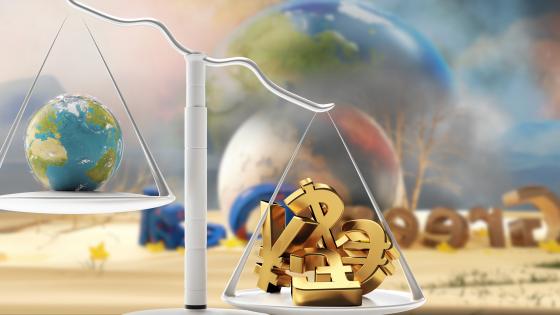Monetary and macroprudential policies: Climate change could matter…
In July 2022, the ECB is taking concrete steps to incorporate climate change into its monetary policy operations (ECB 2022). Amid growing concerns and public demonstrations, central banks have started wondering whether the effects of climate change will call for their intervention. In the past few years, this topic has become increasingly common in their speeches and declarations (Carney 2015, Dikau et al. 2019, Schnabel 2021). In most cases, however, this focus has not yet translated into actual policymaking (Masciandaro and Tarsia 2021). Rather, central banks in developed countries have launched cautious investigations into whether, how, and to what extent they should intervene in climate policy. The ECB’s strategy review is an example in this regard. And now, with inflation soaring, central bankers can face unpleasant trade-offs
This cautious stance stems not only from the different sensibilities of central bankers around this matter but also from their interpretations of the different mandates they must respect. Historically, such mandates have not entailed direct references to climate change, although there have recently been some exceptions in developing countries (Masciandaro and Tarsia 2021). Instead, central bankers generally focus on price and, since the Global Crisis, financial stability, to which is often added a corollary on sustaining or not jeopardising economic growth.
Whether the scope of these mandates could be stretched to allow central banks to take climate-related actions is an open debate from both a policy-oriented and an academic point of view (McKibbin et al. 2020, 2021, Bremus et al. 2021, Boneva et al. 2022a, 2022b, Hartman et al. 2022). On the one hand, some claim that the effects of climate change on economic performance may jeopardise financial stability and that central banks should account for these effects. On the other hand, many suggest that letting central banks take on responsibilities beyond their monetary and macroprudential obligations would make their overall action ineffective. These actors suggest that climate policy should be left to fiscal authorities (Batten et al. 2016).
…but how can central banks can handle it?
So far, research around central banks’ ‘green’ policies has mostly been oriented towards empirical investigations of specific sectors or qualitative analyses of potential central bank tools. It has not focused on justifying policy recommendations based on a general institutional setting that accounts for the interactions and incentives of the two main institutions – government and central bank – and, on top of that, that the central bank can undertake climate action through two toolkits: its monetary and/or macroprudential instruments. In our new research (Masciandaro and Russo 2022) we show that, using a principal–agent setting, it is possible to assess whether the participation of central banks in climate policy would be beneficial, detrimental, or neutral in terms of ‘greening’ the economy, and if this outcome would come at the cost of central banks’ missing their monetary and macroprudential targets.
The institutional setting is such that the government serves as the agent of voters with a climate sensibility, and it leverages the central bank’s own sensibility to its preferences to ensure that it accounts for climate risks within its price and financial stability mandates. Overall, four cases emerge. The first, which only envisions the government intervening in climate policy, represents the benchmark case. Then, it is possible to consider three other settings in which, along with the fiscal tools set by the government, the central bank pursues its price and financial stability mandates under certain climate-related constraints. In so doing, it is possible to consider such constraints to be binding – initially on monetary policy, then on macroprudential policy, and finally on both monetary and macroprudential policy.
The general setting allows us to consider, in a systematic way, the numerous tools of a fiscal, monetary or macroprudential nature that have been so far proposed. In general, one can distinguish between those tools requiring government action and those that have to be put in place by central banks. On the fiscal side, the main instrument that has been proposed and introduced is the carbon tax (or carbon pricing), which is levied on firms in proportion to their CO2 emissions (Stiglitz and Stern 2017, Blanchard and Tirole 2021, BIS 2021, OECD 2021). On the monetary and macroprudential side, possible interventions relate to the inclusion of climate–related risks in capital requirements, climate stress testing and the integration of ESG criteria into asset–purchase programmes (Campiglio et al. 2018, Dafermos et al. 2018, Monnin 2018, De Grauwe 2019, Dikau et al. 2020).
The policies or policy mix that would be the most effective option for reducing pollution is subject to debate (Krogstrup and Oman 2019). While some call for central bank interventions (Campiglio 2016), others claim that any role played by central banks could be detrimental (Tirole 2021) or insufficient if not properly coupled with governmental action (Bolton et al. 2020, McConnell et al. 2022, Dafermos and Nikolaidi 2021, Hansen 2022).
Good news and bad news
Our general results show that monetary and financial dynamics are anchored to the central bank’s targets in all cases, even though the instruments that are set under climate constraints depend on carbon emissions. Therefore, concerns about the capability of central banks to achieve their core objectives and simultaneously account for climate risks do not seem automatically justified.
Nevertheless, two caveats should be highlighted. First, no trade-off emerges only if the central bank is completely independent in setting its strategies, that is, if it is not subject to external pressures – politicians and/or private lobbies – that could force it to pursue a biased level of the target variables. Indeed, even if the central bank accounts for climate risks as a form of delegation by the government, such delegation is implemented in a way that depends exclusively on the degree of its sensibility to the government’s climate preferences. The more the incumbent government can interfere with the central bank preferences, the less the chance of a monetary policy in which climate change considerations can be consistent with monetary and financial stability. The opposite is true if the government’s objectives remain in line with those of the central bank.
Second, with regards to emissions, the results indicate that central banks’ inclusion of climate risks in their policymaking would not necessarily be beneficial to the fight against climate change. Their potential efficacy also depends on their ability to make their ‘green’ easing – monetary and/or regulatory – dependent on the realised level of abatement and emissions. In fact, the only case in which the central bank’s interventions would undoubtedly be beneficial is the one in which it could ensure the full channelling of its resources to the reduction of abatement costs. At least so far, however, this is unlikely to hold in reality. Central banks only have the mandate, and probably the capability, to monitor financial institutions, not the final recipients (i.e. the firms). In other words, lags and frictions can harm the capacity of the central bank to precisely calibrate its green action on the actual emissions of non-financial corporations. All in all, preserving their independence on the one side, and increasing their monitoring capacity on the other, seems to be the Scylla and Charybdis that the central banker, as Odysseus, should consider in designing the new monetary and macroprudential sailing.
References
Boneva, L, G Ferrucci and F P Mongelli (2022a), “Why climate change is relevant for monetary policy”, VoxEU.org, 17 June.
Boneva, L, G Ferrucci and F P Mongelli (2022b), “The role for monetary policy in the green transition”, VoxEU.org, 18 June.
BIS (2021), “Climate–related financial risks: Measurement methodologies”, Basel Committee on Baking Supervision.
Blanchard, O and J Tirole (2021), “Major future economic challenges”, France Stratégie.
Bolton, P, M Despres, L A Pereira da Silva, F Samama and R Svartzman (2020), The Green Swan: Central banking and financial stability in the age of climate change, Banque de France and Bank of International Settlements.
Bremus, F, F Schütze and A Zaklan (2021), “The impact of ECB corporate sector purchases on European green bonds”, DIW Discussion Paper No. 1938.
Campiglio, E. (2016), “Beyond carbon pricing: The role of banking and monetary policy in financing the transition to a low–carbon economy”, Ecological Economics 121: 220–230.
Campiglio, E, Y Dafermos, P Monnin, J Ryan–Collins, G Schotten and M Tanaka (2018), “Climate change challenges for central banks and financial regulators”, Nature Climate Change 8: 462–468.
Carney, M. (2015), “Breaking the tragedy of the horizon – climate change and financial stability”, Speech, Lloyd’s of London.
De Grauwe, P. (2019), “Green money without inflation”, Vierteljahrshefte zur Wirtschaftsforschung 88(2): 51–54.
Dafermos, Y, M Nikolaidi and G Galanis (2018). “Climate change, financial stability and monetary policy”, Ecological Economics 152: 219–234.
Dikau, S, N Robins, U Volz (2020), “A toolbox of sustainable crisis response measures for central banks and supervisors”, INSPIRE Working Paper, London School of Economics and SOAS University of London.
European Central Bank (2022), “ECB Takes Further Steps to Incorporate Climate Change into its Monetary Policy Operations”, Frankfurt, July, 4.
Hansen, L P (2022), “Central banking challenges posed by uncertain climate change and natural disasters”, Journal of Monetary Economics 125: 1–15.
Hartmann, P, A Leonello, S Manganelli, M Papoutsi, I Schnabel and J D Sigaux (2022), “Central Banks, Climate Change, and Economic Efficiency”, VoxEU.org , 10 June.
Krogstrup, S and W Oman (2019), “Macroeconomic and financial policies for climate change mitigation: A review of the literature”, IMF Working Paper No. 19/185.
Masciandaro, D and R Tarsia (2021), “Society, politicians, climate change and central banks: An index of green activism”, Law and Economics Yearly Review 10(1): 34–107.
Masciandaro, D, and R Russo (2022), “Central Banks and Climate Policy: Unpleasant Trade–Offs? A Principal–Agent Approach”, Bocconi University, Baffi CAREFIN Centre Research Paper No. 2022–181.
McConnell, A, B Yanovski and K Lessman (2022), “Central bank collateral as a green monetary policy instrument”, Climate Policy 22(3): 339–355.
McKibbin, W, M Konradt and B Weder di Mauro (2021), “Climate policies and monetary policies in the euro area”, in Beyond the Pandemic: The Future of Monetary Policy, ECB Forum on Central Banking, Conference Proceedings, 28–29 September.
McKibbin, W J, A C Morris, A Panton and P Wilcoxen (2020), “Climate change and monetary policy: issues for policy design and modelling”, Oxford Review of Economic Policy 36(3): 579–603.
Monnin, P (2018), “Central banks and the transition to a low–carbon economy”, Council on Economic Policies Discussion Note 2018/1.
OECD (2021), “Effective carbon rates 2021: Pricing carbon emissions through taxes and emissions trading”.
Schnabel, I (2021), “From green neglect to green dominance?”, speech, European Central Bank.
Stiglitz, J E, N Stern (2017), Report of the High–Level Commission on carbon pricing, CPLC, World Bank.
Tirole, J (2021), “The political economy of climate change”, speech, UBS Center.



